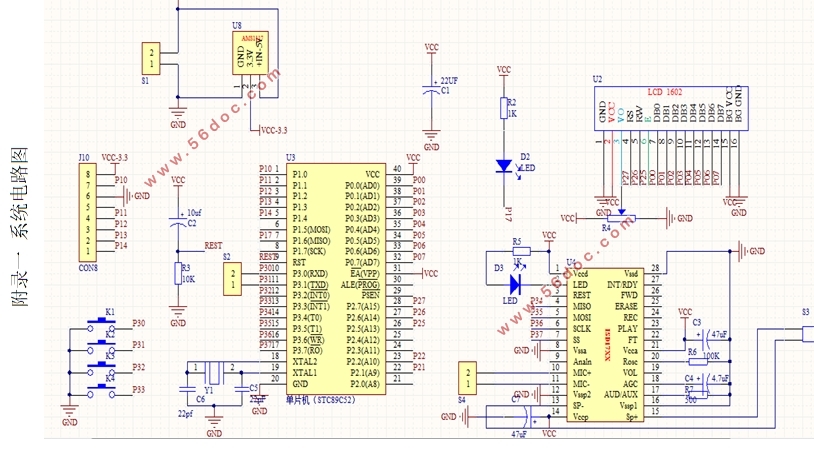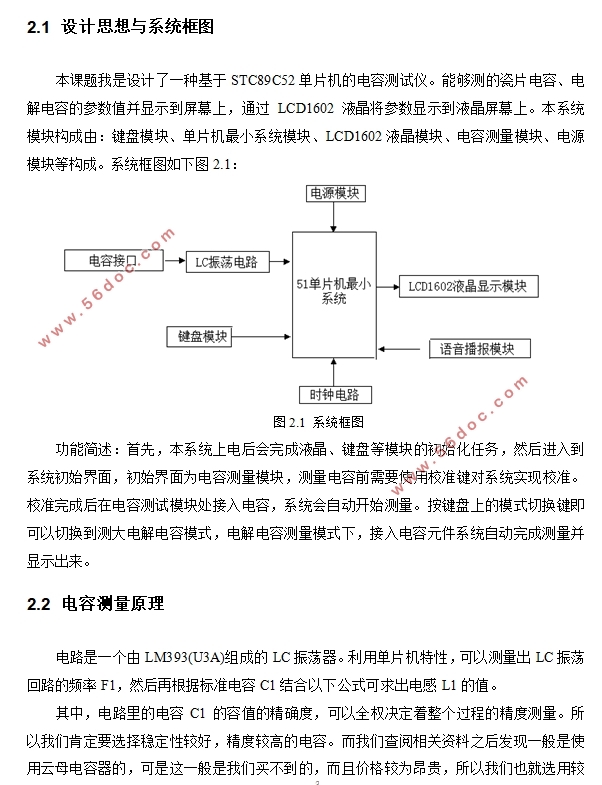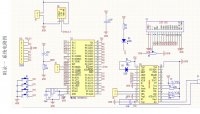基于单片机的电容测试仪设计(论文11000字)
摘 要
目前随着电子工业的高速发展,电子器件的急速增加,电子器件应用范围也更加广泛,因此,在电子产品的检测过程中,测量电容变得至关重要。而一个好产品必须具备长时间的使用寿命,检测产品是否合格关键在于检测其内部核心电路,其中电容在电子产品电路中有着不可替代的作用。所以,设计安全,可靠,便捷的电容测量仪有着巨大的现实意义。
因此,对于RLC等电路参数精确度要求越来越高,对测量仪表有了更高的要求。本次设计作为一种基于AVR单片机连接硬件,结合计数器振荡器以及液晶显示器实现电容的多档位自动检测,数据处理和显示。实现较高的测流量精度。本次设计还添加了语音播报电路,可以更好的实现人机互动。
关键词:电容测量 单片机 AT89C51 语言播报 自动检测
Simple Microcontroller Based Capacitance Tester
Abstract
With the current rapid development of the electronics industry, the rapid increase in electronic devices, electronic devices and more extensive range of applications, therefore, the detection process of electronic products, the measured capacitance becomes critical. And a good product must have a long service life, the key is to detect whether the product is qualified to detect the internal core circuit, wherein the capacitor has an irreplaceable role in the electronics circuit. Therefore, the design safe, reliable and convenient capacitance measuring instrument has great practical significance.
Therefore, the RLC and other circuit parameters accuracy requirements are high, measuring instruments have higher requirements. The design as an attempt to explore the connection using the AVR microcontroller hardware, combined with a liquid crystal display counter oscillator and capacitive multi-gear automatic detection, data processing and display. Achieve high flow measurement accuracy. And this design also adds voice broadcast circuit, we can better achieve human-computer interaction.
Key Words: Capacitance Detection,SCM,AT89C51,Voice broadcast, Automatic detection
2.1 设计思想与系统框图
本课题我是设计了一种基于STC89C52单片机的电容测试仪。能够测的瓷片电容、电解电容的参数值并显示到屏幕上,通过LCD1602液晶将参数显示到液晶屏幕上。本系统模块构成由:键盘模块、单片机最小系统模块、LCD1602液晶模块、电容测量模块、电源模块等构成。



目 录
摘 要 I
Abstract II
第一章 绪论 1
1.1 课题研究的背景 1
1.2 论文所做的工作 2
第二章 系统设计 3
2.1 设计思想与系统框图 3
2.2 电容测量原理 3
2.3 电解电容测量原理 4
第三章 硬件系统设计 6
3.1 单片机最小系统设计 6
3.2 LCD1602液晶显示电路设计 8
3.3 LM393运算放大器 9
3.4 语音播报模块 10
第四章 软件设计 13
4.1 主程序流程图 13
4.2 键盘扫描程序设计 14
4.3 键盘扫描程序设计 14
4.4 频率参数计算的原理 16
第五章 系统调试 18
5.1 硬件调试 18
第六章 总结 21
参考文献 22
附录一 系统电路图 24
附录二 主程序设计 25
|







